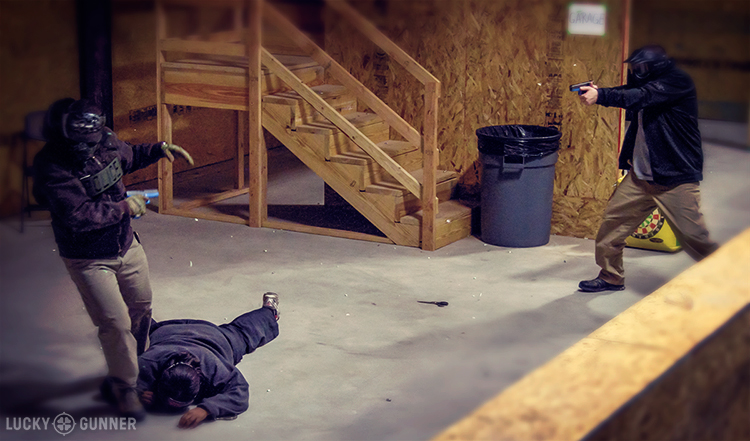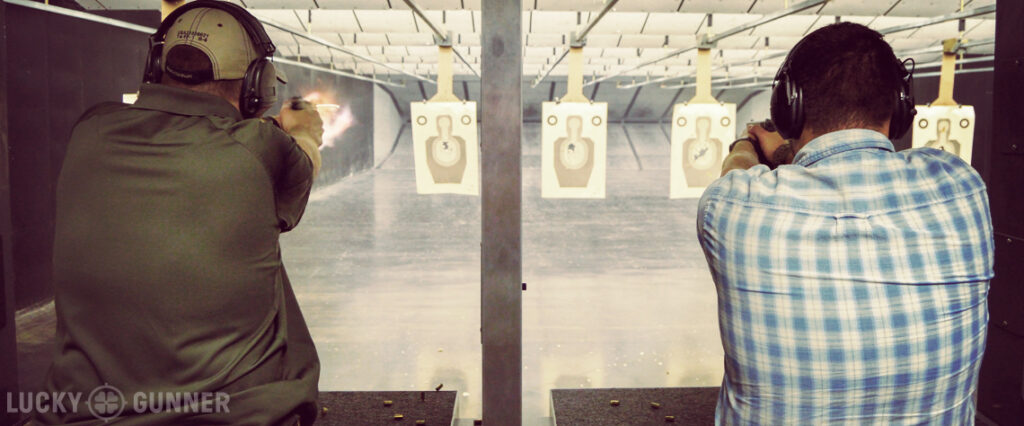A few months ago, I had a defensive encounter that I will not soon forget. Like so many self-defense stories, this one took place in an isolated, dimly-lit location, the kind we should all avoid whenever possible. Without provocation, a dingy, sketchy looking man in dirty jeans and an old, worn jacket approached me and a bystander and began yelling in our direction. With no good exit route and not wanting to be just another victim, I met him head on and attempted to control the situation with aggressive body posture and vocal commands to calm down, knowing that as my heart-rate began to spike, a Glock 17 was holstered beneath my shirt as my last resort.
After some heated back and forth shouting, I found myself watching a pistol coming up from the thug’s waistline. I closed the distance and grabbed the thug’s arm with my left hand as I tried to draw my own weapon from my IWB holster. After a short scuffle, I managed to get control of my weapon, clear a malfunction induced by the tangle of limbs and clothes, and deliver 4 or 5 rounds to the center mass of my attacker, dropping him on the spot. Unfortunately, before I did any of that, I took a near-contact shot to my left temple which would have killed me instantly. I later learned that I would have caught even more rounds if my attacker’s gun had not malfunctioned as well.
Fortunately for me, this wasn’t a true life or death situation but instead, a training scenario complete with Simunition pistols firing special non-lethal marking ammunition. The “thug” was actually a former undercover police officer and our instructor for the exercise. The location wasn’t a parking garage or empty street corner, but a warehouse addition normally meant for 3-D archery. I assure you though, the adrenaline was quite real, as was the hit to my ego.

This training scenario was part of a course titled “Establishing a Dominance Paradigm,” which, if I’m being honest, is not a course title that would typically pique my interest. It sounds a little too abstract and buzzword-y. I remember wondering what it could possibly offer me, someone who has, at least in a military fashion, “been there, done that, and got the T-shirt.” In fact, I only attended the course because Lounge editor Chris wasn’t able to make it and the training facility happened to be quite close to home. It’s not every day that you get to evaluate something without having any sort of personal stake in it; there was no real monetary investment in attending and I had no relationship with the instructors, positive or negative. If anything, I was initially very skeptical, waiting to be faced with frustrating no-win scenarios and “gotcha!”-style instructor debriefs. In hindsight, I really couldn’t have been more wrong.
EDP is taught by a veritable super-group of instructors: Tom Givens of Rangemaster Firearms Training Services, William Aprill of Aprill Risk Consulting, and Craig Douglas of ShivWorks. While all of them have spent several years as law enforcement officers, they each have a primary specialty that they focus their teaching on: firearms instruction, criminal behavior, and force-on-force training, respectively. The 3-day course was an incredibly enlightening and eye-opening experience covering the entire spectrum of factors that play into lethal-force situations on the street. We covered topics like how criminals develop and select their targets, how they act face-to-face, and how to put shots exactly on target under authentic severe stress. It is the best single course I can imagine someone taking in order to become a more aware, more prepared, and more competent armed citizen. And, it has led me to question a lot about how we as shooting enthusiasts often approach defensive training, particularly with respect to concealed carry.
“…it definitely highlighted to me one of the huge shortcomings inherent to gun-range defensive training: real defensive situations involve so much more than just pulling the trigger.”
While walking back to the main classroom after getting unceremoniously shot in the head, I could only think to myself, “I really thought I would do better than that.” I’m sure many of the other students thought the same thing, but it definitely highlighted to me one of the huge shortcomings inherent to gun-range defensive training: real defensive situations involve so much more than just pulling the trigger. As I debriefed with the instructors and watched the video playback of my encounter projected on the screen in front of the entire class, I was actually very pleased with my shooting ability, it’s just that everything besides my shooting ability had already gotten me killed.
Going back, I was able to see how and where I went wrong as I involved myself with the assailant and how just about every one of my actions actively contributed to the thug drawing the gun. I found that I inadvertently gave control of the situation to my aggressor by simply matching his aggression instead of exceeding it to control the situation, or as the best students decided to do, retreating to prepare an ambush. Even though my reaction to the gun was immediate, my response was divided and ultimately unsuccessful. So while it stung a bit (or a lot) that I had failed my scenario despite my background, it forced me to wonder if I really had any right to expect better.
One of the lesser discussed elements of concealed carry is that it really does offer a unique set of circumstances when compared to the actions of military and police. As a Marine in Afghanistan, I may have faced greater threats than street thugs, but I had factors in my favor as well; namely backup, free access to my rifle, and body armor. As an average person on the street we may not assume the same odds of encountering a deadly situation as do military and police, but we do find ourselves much less prepared to deal with one should it arise. The only advantage an armed citizen has when targeted by a criminal is the enemy’s lack of threat anticipation, and if all we ever do is put holes in paper on the range, are we really working on maximizing that advantage?
“If we’re being honest though, we hold our equipment to a much higher standard than we hold ourselves.”
I’ve always found it a little amusing what the gun community at large typically focuses on when it comes to self-defense. We champion our preferred ammo for its ballistics-gel performance, and largely we accept nothing less than absolute reliability of our carry gun, be it after 1,000 rounds without a cleaning or sometimes even caked in sand and mud. If we’re being honest though, we hold our equipment to a much higher standard than we hold ourselves. The problem is that no matter what brand of gun you carry, it isn’t going to get you safely out of a bind on its own. Unfortunately, it isn’t often that you come across the opportunity to put the time and effort into developing the software to go along with the hardware. Perhaps that’s due to the relative obscurity of broad-spectrum training like EDP in the face of whiz-bang shooting courses promising to make you laser accurate and lightning fast in a weekend. In fact, the turnout for my class was just 10 students, and for many of those, this was not their first course with the instructors present.
On the one hand it’s understandable; good courses are in short supply (this particular course is only offered once a year) and they require a substantial commitment in terms of time and money. On the other hand, you have to face the fact that the majority of people who have undertaken the responsibility of carrying the power of life and death with them in their daily lives don’t actually prepare for the full scope of the situation they want to be ready to face. That means having to deal with a real person and the real issues that arise when things don’t go exactly how you want them to.
Imagine it this way–an aspiring boxer wouldn’t prepare for a fight solely by punching a speed-bag. His rhythm and cardiovascular endurance can certainly help, but he hasn’t learned how to react to punches or how to maneuver intelligently around the ring. If his opponent is used to fighting or at least sparring, he’ll beat him handily even if his technique is substandard. After failing pretty miserably initially, I made significant progress through a variety of scenarios over just a few days of EDP. I can’t help but think that the gun community as a whole could use a lot more “sparring”; more force-on-force with real people and well-simulated weapons instead of the usual arrangement of real weapons and very poorly simulated people. It’s not even necessarily gun owner training apathy as it is a lack of options. Shooting courses have a much broader appeal, and while they’re far from worthless, their prevalence compared to courses like EDP tends to build the idea that shooting proficiency is all you need to succeed.
One of the things I appreciated most about Tom Givens’ teaching approach is his conviction toward concealed carrying. It isn’t morbid, but it isn’t sugar-coated either. Your gun is on your person not for some vague concept like “protection” or “defense,” but you are armed because you may have to shoot someone today, in an hour, or in five minutes. While that may seem somewhat dramatic to more casual carriers out there, it’s hard not to agree with him. “It’s not the odds, it’s the stakes,” he told us, and that was not just poignant on the issue of carrying a gun but also with regard to the full-spectrum training we were engaged in.
Certainly many people in America each year find that they’re able to defend themselves without having done elaborate force-on-force training scenarios with role-players and Simunition guns. The odds certainly seem in favor of merely having a gun and knowing how to use it as enough to win the fight. But as armed citizens, we can’t just be concerned with the odds. We must also be concerned with the stakes involved. Given that, it might be worthwhile to put ourselves in a position to get an honest evaluation of our response to stress, aggression, and force. It’s personal, it’s frustrating, and it’s sometimes embarrassing. However, quality force-on-force training will help you know what to do if the day comes that a criminal decides to bring violence into your world.
To that end, Establishing a Dominance Paradigm is a truly excellent course as a full-spectrum boot-camp to understanding daily risks and how to deal with them. If the course location and time is incompatible with your schedule, instructor Craig Douglas teaches all over the nation with a heavy focus on dealing with people face to face and the various dynamics involved with real physical confrontations. So, if you’re serious about defensive preparedness and are already a competent shooter, it may be time to think outside the gun-range when it comes to training, and if you know of some great training programs that go beyond firearms manipulation, let us know in the comments!

